Gene Profiling in the Adipose Fin of Salmonid Fishes Supports Its Function as a Flow Sensor
Abstract
1. Introduction
2. Materials and Methods
2.1. Fish and Sampling
2.2. Gene Selection and Primer Design
2.3. RNA Preparation and cDNA Synthesis
2.4. Gene-Expression Profiling via qPCR
2.5. Data Analysis
3. Results
3.1. The Adipose Fin Showed High Levels of Neuron Marker Expression
3.2. Genes Coding for Mechanoreceptor Proteins were Expressed in the Adipose Fins
3.3. Comparison of Gene Expression between Salmonid Species
4. Discussion
4.1. Gene-Expression Profiling Indicates the Innervation of the Salmonid Adipose Fin
4.2. The Expression of Neuron- and Glial-Cell Markers Is Tissue-Specific in Salmonids
4.3. Mechanosensation Is a Characteristic of the Salmonid Adipose Fin
5. Conclusions
Author Contributions
Funding
Acknowledgments
Conflicts of Interest
Appendix A
| (A) | (B) | (C) | (D) | (E) | (F) | (G) |
|---|---|---|---|---|---|---|
| Gene Symbol | Localization | Basic Function | Accession Code of Selected Ortholog of (A) in O. mykiss (Incl. Chromosome no.) | Accession Code of Paralogs of (D) in O. mykiss (Chromosome no.; % CDS Divergence to [D]) | Sense and Antisense Primer Sequence (5’-3’) Derived from (D) | Prediction of Specificity of Primers (F) for Selected Ortholog (D) |
| Neuron marker | ||||||
| NEFL | Axon | Neurofilament | XM_021605918 (6) | XM_021621429 (11; 91.4%) XM_021602316 (5; 71.1%) XM_021590833 (29; 70.6%) | CTTACAGGAAGCTGCTTGAAGG, GATGAGCTGTACATGCGTAGGT | Binding to XM_021621429 (no mismatch), but not to XM_021602316, XM_021590833 (antisense: 6 and 7 mismatches) |
| NEFH | Myelinated axons | Neurofilament | XM_021621725 (11) | XM_021606185 (6; 91.2%) | GTGAGTCACTAACACACTGCATA, TGTTTGTCTCCTGCTCTGCTCT | Not binding to XM_021606185 (sense: 6 mismatches) |
| PRPH | Unmyelinated axons | Neurofilament | XM_021610098 (7) | XM_021569035 (17; 92.2%) | ACGTGCAGGTGAGTGTCCAGA, AGGTCAGCAAACTTGGACTTGTA | Binding to both paralogs (sense: 2 mismatches) |
| TUBB3 | Axon | Microtubule assembly | XM_021607465 (6) | XM_021586327 (26; 98.8%) XM_021580863 (23; 85.0%) | AGGCCTCATCCTCTAAGTACGT, CCTTGGCCCAGTTGTTACCAG | Binding to XM_021586327, but not to XM_021580863 (sense: 6 mismatches) |
| PVALB7 | Myelinated axon | Calcium binding | XM_021557489 (13) | XM_021624534 (12; 97.4%) | CGCAGCGGCTGACTCTTTTGA, GAGGCAAATCCCTTCAGTACGA | Binding to both paralogs (sense: 1 mismatch) |
| STMN2 | Axon | Microtubule dynamics | XM_021559849 (14) | XM_021598102 (3; 84.4%) XM_021585013 (3; 84.7%) XM_021572874 (18; 96.8%) | TGGCTAAAACAGCAATTGCGTAC, AGAGGCACGCTTGTTGATGGG | Not binding to XM_021598102 XM_021585013, XM_021572874 (3 to 10 mismatches per primer) |
| MAP2 | Neuron dendrites | Microtubule assembly | XM_021597500 (3) | XM_021579611 (22; 86.9%) | CGTCAAGAAGAAAAAAGCCGTGA, ACTGTAGGTTTCCTCCTAGCAC | Binding to both paralogs (sense: 1 mismatch) |
| RBFOX3 | Neuronal nucleus | Neuronal nucleus production | XM_021581050 (23) | XM_021576584 (20; 86.7%) XM_021625440 (12; 81.2%) XM_021556260 (13; 84.3%) | AGTATCGCAGGCAGAAGAGGTT, CCCAAACATTTGCCTGAGGTCT | Binding to XM_021576584, but not binding to XM_021625440, XM_021556260 (sense: 9-nt gap) |
| Glial cell and glial cell type marker | ||||||
| GFAP | Astrocytes and Schwann cells (SC) | Cell communication | XM_021558456 (13) | XM_021625581 (12; 98.9%) | TGACGGAGCTGACCCAACTGA, TCTCATCTTGCAGTCTCTGTTTG | Binding to both paralogs (no mismatch) |
| ALDH1L1 | Astrocytes and liver cells | Energy supply | XM_021610613 (7) | ―――――― | GAACAGCTATCTGTGATGTGTCT, TCCATCAGGTCAGCCAGCTTAT | |
| MBP | Myelinating SC and oligo-dendrocytes | Myelin formation | XM_021571745 (18) | XM_021594735 (?; 92.8%) | ATCAGATTAGCACGTTCTTTGG, AGAGGCTGTCACGCTCAAGCT | Not binding to XM_021594735 (antisense: 39-nt gap) |
| MPZ | Myelinating SC and oligo-dendrocytes | Myelin formation | XM_021588760 (28) | XM_021614027 (8; 93.3%) | ATCTACACGGGCTGGGAGCG, CCGGTGTAGTGGAAGATAGAGA | Binding to XM_021614027 (antisense: 3 mismatches) |
| PMP22 | Myelinating SC and oligo-dendrocytes | Myelin formation | XM_021576248 (20) | XM_021581303 (23; 92.2%) XM_021559021 (13; 77.5%) | TCTTCCAGATCCTCGCCAGTC, TGACGTAGATGAGTCCGCTGAT | Binding to XM_021581303 (antisense: 1 mismatch), but not to XM_021559021 (antisense: 5 mismatches) |
| S100B | Glial cells and neurons | Calcium binding | XM_021608876 (7) | XM_021571442 (18; 96.5%) | ATTACAAACCACAATGACTGACCT, TGGTCCTTCACTTGCCCTGTAA | Binding to XM_021571442 (sense: 1 mismatch) |
| NCAM1 | Glial cells and neurons | Cell contact and communication | XM_021617837 (10) | XM_021623770 (12; 91.5%) XM_021588052 (27; 74.7%) XM_021582629 (24; 75.7%) | AGAAGCTTTTACCGAACAGACAG, TTTGGAAGATTTTCACGTTGACAG | Binding to XM_021623770 (2–3 mismatches), but not to XM_021588052, XM_021582629 (sense: ≥9-nt gap) |
| SOX10 | Glial cells and neurons | Neuron survival | XM_021567709 (17) | XM_021556808 (13; 98.7%) XM_021558042 (13; 75.4%) XM_021625106 (12; 75.2%) | CGCGTAAACAACGGGAACAAGA, ATTCAGGAGCCTCCACAGTTTG | Binding to XM_021556808 (no mismatch), but not to XM_021558042, XM_021625106 (antisense: 5–7 mismatches) |
| Neuron characterization | ||||||
| NGFR | Glial cells and neurons | Neuron assembly and survival | XM_021558479 (13) | XM_021625607 (12; 98.2%) XM_021565429 (16; 80.6%) | CAGTGCCTAGACAGTGAGACC, CCTCATTCAGGTAGTAGTTGTAG | Binding to XM_021625607 (no mismatch), but not to XM_021565429 (sense: 38-nt gap) |
| NTRK2 | A-delta LTMR | Signalling and neuron survival | XM_021605433 (6) | XM_021621031 (11; 93.7%) XM_021602994 (5; 84.8%) XM_021622759 (12; 85.2%) | CCTCACGAATCTAACTGTGACTA, AGCGGGTTCCCTGAAAGAATCA | Binding to XM_021621031 (no mismatch), but not to XM_021602994, XM_021622759 (antisense: ≥6 mismatches) |
| NTRK3 | Proprioceptors and LTMR | Signalling and neuron survival | XM_021591923 (1) | XM_021568341 (2; 94.9%) XM_021593111 (?; 82.3%) | CAAGAACATCACCTCAATACACAT, GGTTCTTCGATAAGTTTATGTAGC | Not binding to XM_021593111 |
| GFRa2 | C-LTMR | Signalling and neuron survival | XM_021605433 (6) | XM_021621031 (11; 93.7%) XM_021602994 (5; 84.8%) XM_021622759 (12; 85.2%) | ATTATCTCAGGGATGCACACTGT, TGGCAGCGCTTACGGTTACAC | Not binding to XM_021621031, XM_021622759, XM_021602994 (sense: ≥ 4-nt gap) |
| Receptor/synapse characterization | ||||||
| SLC1A2 | Glial cells, neurons, receptors | Glutamate transport | XM_021600639 (1) | XM_021573109 (2; 94.2%) XM_021608174 (6; 82.2%) XM_021625950 (12; 80.4%) | AACAGATCCAAACGGTTACTAAGA, TAACACGTTCATGCCACTCTTGA | Binding to XM_021573109 (2–3 mismatches), but not to XM_021625950 (sense: 18-nt gap) and XM_021608174 (7 mismatches) |
| SLC17A7 | Glial cells, neurons, receptors | Glutamate transport | XM_021575504 (20) | XM_021565125 (16; 94.4%) XM_021558924 (13; 80.2%) | TACGGCAGCTTTGGGATCTTCT, AAAAGGCTCTCCAAGGCGTGTT | Binding to XM_021565125 (sense: 1 mismatch), but not to XM_021558924 (sense: 12-nt gap) |
| SLC17A8 | Glial cells, neurons, receptors | Glutamate transport | XM_021601245 (1) | XM_021574127 (2; 93.4%) | TATGGTGTATTTGGGATCATATGG, GAATTTCTCAGTGGCGCTCAATA | Binding to XM_021574127 (sense, antisense: 1 mismatch) |
| TH | Glial cells, neurons, receptors | Dopamine synthesis | XM_021564247 (2) | ―――――― | TGTTCGAGACGTTTGAAGCTAAG, GTTTTGACATCCTCTGCTATCCT | |
| TPH2 | Glial cells, neurons, receptors | Serotonin synthesis | XM_021576444 (2) | ―――――― | GCCCTACGCCTTTTTCAGGAG, AGGCGTGTTGAAGGAGATGATAT | |
| SULT4A1 | Neuron nucleus | Purposed neuro-transmitter synthesis | XM_021577380 (21) | XM_021564205 (15; 99.5%) | CCCAGATGAGATTGGTCTGATG, TCGCCATGTAGATCACCTTGGA | Binding to XM_021564205 (no mismatch) |
| Mechanoreceptor characterization | ||||||
| PIEZO2 | Afferent neuron ending and receptors | Stretch-receptor channel | XM_021588681 (28) | XM_021590114 (28; 90%) XM_021614324 (8; 88.0%)/ XM_021614323 (8; 87.5%)/ XM_021614322 (8; 94.8%), XM_021622313 (11; 78.3%), XM_021564358 (15; 80.2%) | GATAGTATATCCAGTGCCTACAC, CTACTGCTGCTGTCAGTCGATT, AGAGAGGTCAAAAAGGGCAACG, TCCTGGCTCTCCATGCGATAG, AACTGTGATGTAACAACGGTAAG, ACGTCCTCTGGTGGTCTGTTTT | Pair 1 binding to XM_021588681 and XM_021614324; pair 3 binding to XM_021614324; pair 4 binding to XM_021588681; no pair binds to XM_021590114, XM_021622313, XM_021564358 (sense: >4 mismatches or 20-nt gap) |
| PIEZO1 | Non-sensory tissues | Stretch-receptor channel | XM_021585995 (26) | XM_021607119 (6; 97.1%) | ACTGTAGTTTGTGGGAGACGCT, TCTCTTCTTGACCAGCCGGTTA | Binding to XM_021607119 (1–3 mismatches) |
| ASIC1 | Receptors | Mechano-receptor channel | XM_021615628 (9) | XM_021566621 (16; 94.3%) XM_021610711 (7; 82.15%) XM_021567553 (17; 79.0%) | AGACGGATGAGACCACGTTTGA, AGGGTGGGGGCAAATATATCAG | Binding to XM_021566621 (sense: 3 mismatches), but not to XM_021610711, XM_021567553 (sense, antisense: ≥5 mismatches) |
| ASIC2 | Receptors | Mechano-receptor channel | XM_021558500 (13) | XM_021625621 (12; 98.7%) | CTGCCCTTGCCAAGTTGTCAAT, TGTTATCCGTGATGTATTTCTCAG | Binding to XM_021625621 (no mismatch) |
| ASIC4 | Receptors | Mechano-receptor channel | XM_021579184 (22) | XM_021596998 (3; 96.5%) | ATATCCAACAGGACGAGTATCTC, GGTCAGCCTTTGTTCCTGACAT | Binding to XM_021596998 (sense: 1 mismatch) |
| TRPC1 | Receptors | Mechano-receptor channel | NM_001185053 (11) | ―――――― | TAAGCCCTCCATCGCTAAACTG, GGCATTACAGAGAGTACACTCG | |
| KCNK2 | Receptors | Mechano-receptor channel | XM_021600681 (4) | ―――――― | GTGACTTTGTGGCCGGTGAAAA, CCCCTACCTCCTCCTTGGTTT | |
| KCNK4 | Receptors | Mechano-receptor channel | XM_021583157 (25) | XM_021561640 (14; 87.6%) | CAGCGACCTCATAAAGAGTGTG, GTCCTGGGAGAAAGGTTACCAA | Binding to XM_021561640 (sense, antisense: 2–3 mismatches) |
| KCNK10 | Receptors | Mechano-receptor channel | XM_021574081 (19) | XM_021583031 (25; 90.5%), XM_021611349 (8; 72.7%) | GTGGAGAAGATATACAGGCAAAAA, TGATAGCGTGATGATGACAAAGTA | Not binding to XM_021583031 (sense or antisense: ≥4 mismatches) |
| CACNA1H | Action potential generation zone | Modulation of firing patterns | XM_021593500 (?) | ―――――― | CGCTAGAGTGTTGAAGCTGTTG, TCTCCTCGGAACACTCCAGTTT | |

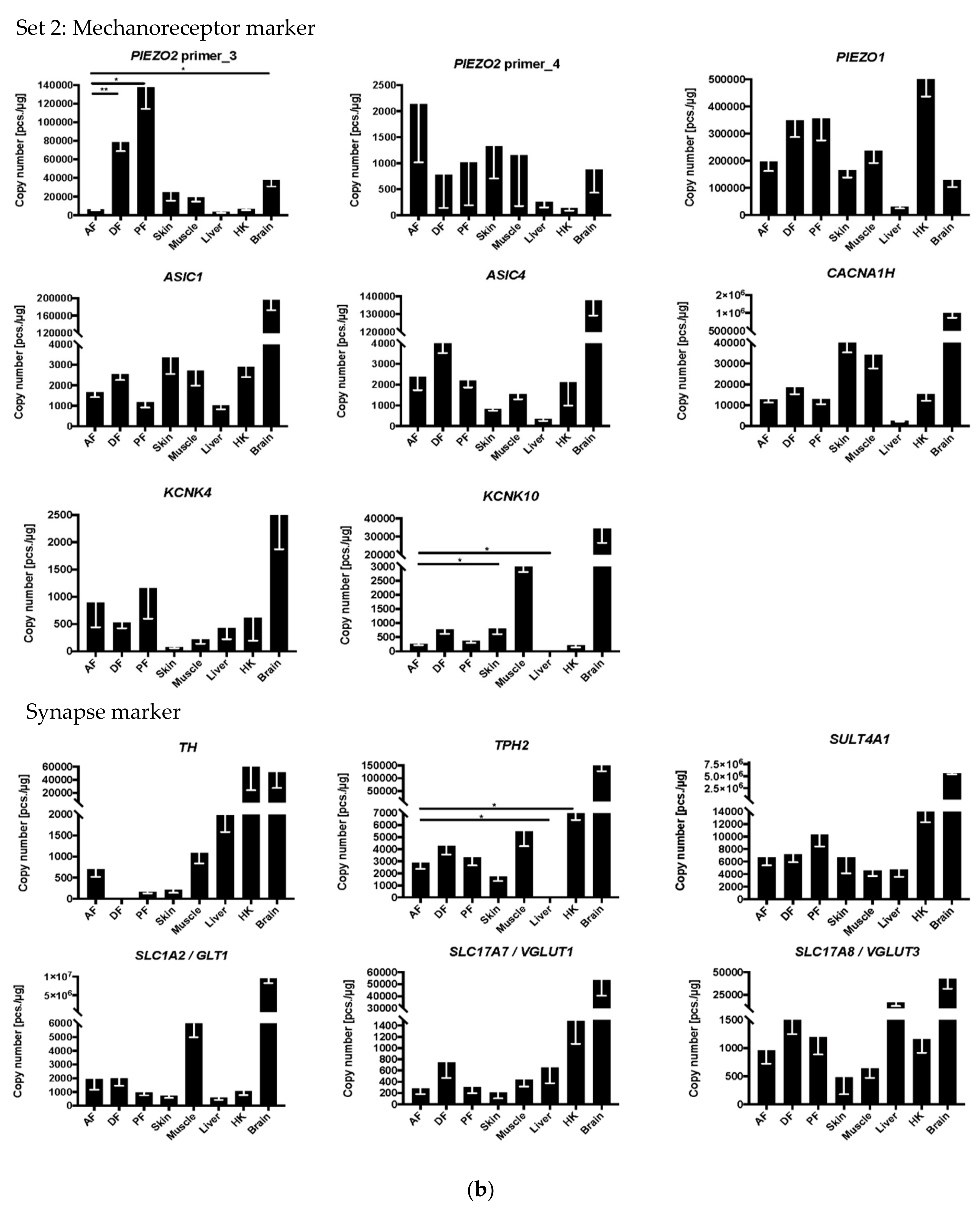
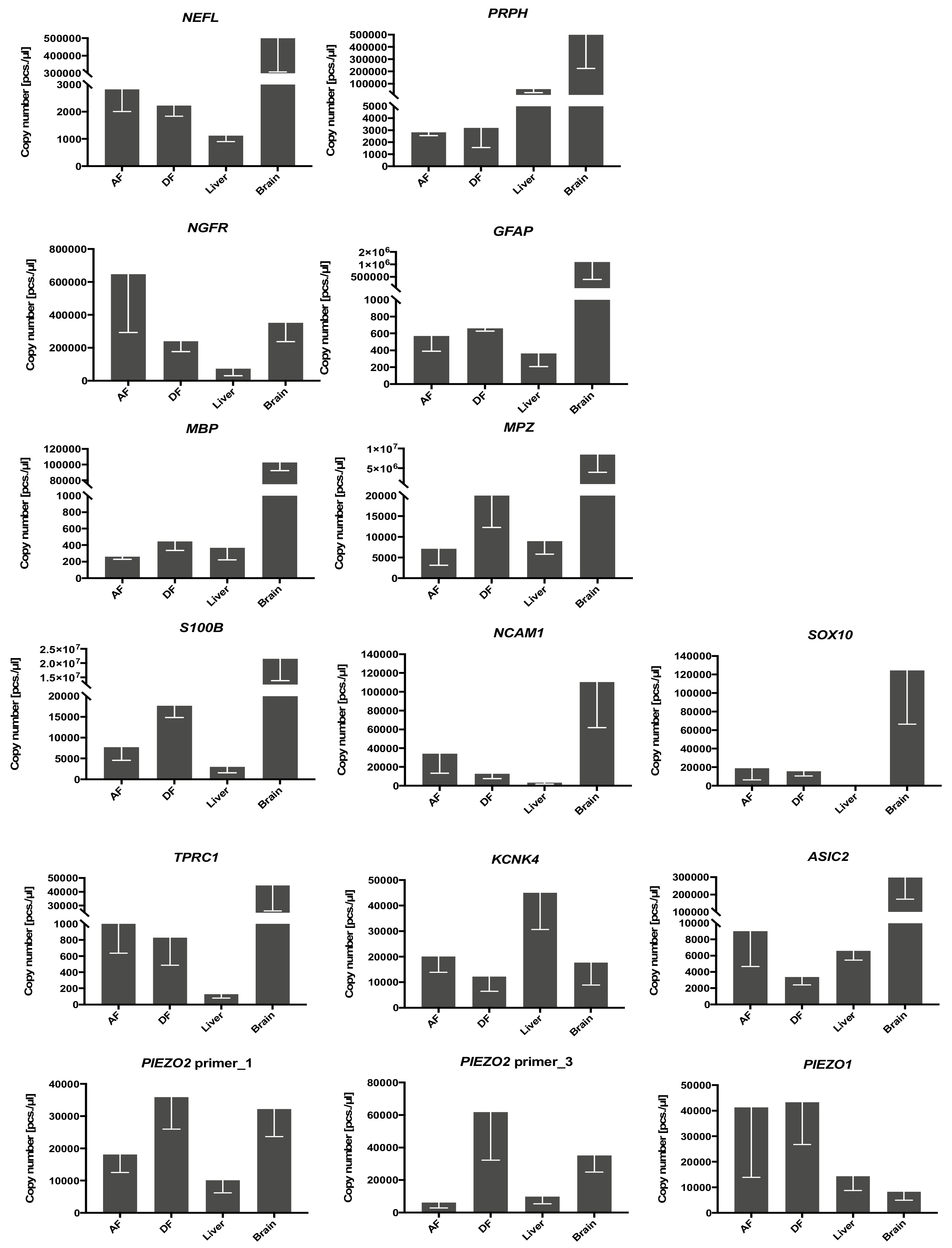

References
- Macqueen, D.J.; Primmer, C.R.; Houston, R.D.; Nowak, B.F.; Bernatchez, L.; Bergseth, S.; Davidson, W.S.; Gallardo-Escárate, C.; Goldammer, T.; Guiguen, Y.; et al. Functional Annotation of All Salmonid Genomes (FAASG): An international initiative supporting future salmonid research, conservation and aquaculture. BMC Genom. 2017, 18, 484. [Google Scholar] [CrossRef]
- Stewart, T.A.; Smith, W.L.; Coates, M.I. The origins of adipose fins: An analysis of homoplasy and the serial homology of vertebrate appendages. Proc. R. Soc. B Biol. Sci. 2014, 281, 20133120. [Google Scholar] [CrossRef] [PubMed]
- FAO. The State of World Fisheries and Aquaculture (SOFIA) 2014; Fisheries and Aquaculture Department: Rome, Italy, 2014. [Google Scholar]
- North Pacific Anadromous Fish Comission (NPAFC). ICES ICES WGBAST Report 2018. In Proceedings of the Report of the Baltic Salmon and Trout Working Group (WGBAST), Turku, Finland, 20–28 March 2018; pp. 11–20. [Google Scholar]
- ICES. ICES WGBAST Report 2018 Report of the Baltic Salmon and Trout Working Group (WGBAST); Ices Advisory Committee: Turku, Finland, 2018. [Google Scholar]
- Bourret, V.; O’Reilly, P.T.; Carr, J.W.; Berg, P.R.; Bernatchez, L. Temporal change in genetic integrity suggests loss of local adaptation in a wild Atlantic salmon (Salmo salar) population following introgression by farmed escapees. Heredity 2011, 106, 500–510. [Google Scholar] [CrossRef] [PubMed]
- Akimenko, M.A.; Marí-Beffa, M.; Becerra, J.; Géraudie, J. Old questions, new tools, and some answers to the mystery of fin regeneration. Dev. Dyn. 2003, 226, 190–201. [Google Scholar] [CrossRef] [PubMed]
- Armstrong, G.C. Mortality, rate of growth, and fin regeneration of marked and unmarked lake trout fingerlings at the provincial fish hatchery, Port Arthur, Ontario. Trans. Am. Fish. Soc. 1949, 77, 129–131. [Google Scholar] [CrossRef]
- Stauffer, T.M.; Hansen, M.J. Mark retention, survival, and growth of jaw-tagged and fin- clipped rainbow trout. Trans. Am. Fish. Soc. 1969, 98, 225–229. [Google Scholar] [CrossRef]
- Weber, D.; Wahle, R.J. Effect of Finclipping on Survival of Sockeye Salmon (Oncorhynchus nerka). J. Fish. Res. Board Can. 1969, 26, 1263–1271. [Google Scholar] [CrossRef]
- Johnsen, B.O.; Ugedal, O. Effects of different kinds of fin-clipping on over-winter survival and growth of fingerling brown trout, Salmo trutta L., stocked in small streams in Norway. Aquac. Res. 1988, 19, 305–311. [Google Scholar] [CrossRef]
- VKM. Risk Assessment of Marking and Tracing Methods with Regards to the Welfare of Farmed Salmonids. Opinion of the Panel on Animal Health and Welfare, Oslo, Norway; Norwegian Scientific Committee for Food Safety (VKM): Oslo, Norway, 2016; ISBN 9788282592574. [Google Scholar]
- ICES. ICES WGBAST Report 2007. In Proceedings of the Report of the Baltic Salmon and Trout Working Group ( WGBAST), Riga, Latvia, 27 March–4 April 2017; pp. 11–20. [Google Scholar]
- Washington Department of Fish and Wildlife (WDFW). Hatchery Fish. Mass-Marking; Washington Department of Fish and Wildlife (WDFW): Takoma Park, MD, USA, 2019. [Google Scholar]
- Saunders, R.L.; Allen, K.R. Effects of tagging and fin-clipping on the survival and growth of Atlantic salmon between smolt and adult stages. J. Fish. Res. Board Can. 1967, 24, 2595–2611. [Google Scholar] [CrossRef]
- Nicola, S.J.; Cordone, A.J. Effects of fin removal on survival and growth of rainbow trout (Salmo gairdneri) in a natural environment. Trans. Am. Fish. Soc. 1973, 102, 753–758. [Google Scholar] [CrossRef]
- O’Grady, M.F. The Effects of Fin-Clipping, Floy-Tagging and Fin-Damage on the Survival and Growth of Brown Trout (Salmo trutta L.) Stocked in Irish Lakes. Fish. Manag. 1984, 152, 49–58. [Google Scholar] [CrossRef]
- Gjerde, B.; Refstie, T. The effect of fin-clipping on growth rate, survival and sexual maturity of rainbow trout. Aquaculture 1988, 73, 383–389. [Google Scholar] [CrossRef]
- Hansen, L.P. Effects of Carlin tagging and fin clipping on survival of Atlantic salmon (Salmo salar L.) released as smolts. Aquaculture 1988, 70, 391–394. [Google Scholar] [CrossRef]
- Vander Haegen, G.E.; Blankenship, H.L.; Hoffmann, A.; Thompson, D.A. The Effects of Adipose Fin Clipping and Coded Wire Tagging on the Survival and Growth of Spring Chinook Salmon. N. Am. J. Fish. Manag. 2005, 25, 1161–1170. [Google Scholar] [CrossRef]
- Bumgarner, J.D.; Schuck, M.L.; Blankenship, H.L. Returns of Hatchery Steelhead with Different Fin Clips and Coded Wire Tag Lengths. N. Am. J. Fish. Manag. 2009, 29, 903–913. [Google Scholar] [CrossRef]
- Reimchen, T.E.; Temple, N.F. Hydrodynamic and phylogenetic aspects of the adipose fin in fishes. Can. J. Zool. 2004, 82, 910–916. [Google Scholar] [CrossRef]
- Buckland-Nicks, J.A. New details of the neural architecture of the salmonid adipose fin. J. Fish. Biol. 2016, 89, 1991–2003. [Google Scholar] [CrossRef]
- Aiello, B.R.; Stewart, T.A.; Hale, M.E. Mechanosensation in an adipose fin. Proc. R. Soc. B Biol. Sci. 2016, 283, 20152794. [Google Scholar] [CrossRef]
- Garstang, W. The phyletic classification of Teleostei. Proc. Leeds Philos. Lit. Soc. Sci. Sect. 1931, 2, 240–261. [Google Scholar]
- Temple, N.F.; Reimchen, T.E. Adipose fin condition and flow regime in catfish. Can. J. Zool. 2008, 86, 1079–1082. [Google Scholar] [CrossRef]
- Sneddon, L.U.; Elwood, R.W.; Adamo, S.A.; Leach, M.C. Defining and assessing animal pain. Anim. Behav. 2014, 97, 201–212. [Google Scholar] [CrossRef]
- Sneddon, L.U. Trigeminal somatosensory innervation of the head of a teleost fish with particular reference to nociception. Brain Res. 2003, 972, 44–52. [Google Scholar] [CrossRef]
- Ashley, P.J.; Sneddon, L.U.; McCrohan, C.R. Nociception in fish: Stimulus-response properties of receptors on the head of trout Oncorhynchus mykiss. Brain Res. 2007, 1166, 47–54. [Google Scholar] [CrossRef] [PubMed]
- Sneddon, L.U. Pain perception in fish: Indicators and endpoints. ILAR J. 2009, 50, 338–342. [Google Scholar] [CrossRef]
- Sneddon, L.U.; Braithwaite, V.A.; Gentle, M.J. Do fishes have nociceptors? Evidence for the evolution of a vertebrate sensory system. Proc. R. Soc. B Biol. Sci. 2003, 270, 1115–1121. [Google Scholar] [CrossRef]
- Li, L.; Rutlin, M.; Abraira, V.E.; Cassidy, C.; Kus, L.; Gong, S.; Jankowski, M.P.; Luo, W.; Heintz, N.; Koerber, H.R.; et al. The functional organization of cutaneous low-threshold mechanosensory neurons. Cell 2011, 147, 1615–1627. [Google Scholar] [CrossRef]
- Victoria, E.A.; David, D. Ginty Neuron The Sensory Neurons of Touch. Neuron 2013, 79, 1–44. [Google Scholar]
- François, A.; Schüetter, N.; Laffray, S.; Sanguesa, J.; Pizzoccaro, A.; Dubel, S.; Mantilleri, A.; Nargeot, J.; Noël, J.; Wood, J.N.; et al. The Low-Threshold Calcium Channel Cav3.2 Determines Low-Threshold Mechanoreceptor Function. Cell Rep. 2015, 10, 370–382. [Google Scholar] [CrossRef]
- Lechner, S.G. Neue Einsichten in die spinalen und peripheren Signalwege der Schmerzentstehung. e-Neuroforum 2017, 23, 173–178. [Google Scholar] [CrossRef]
- Brierley, S.M. Molecular basis of mechanosensitivity. Auton. Neurosci. Basic Clin. 2010, 153, 58–68. [Google Scholar] [CrossRef]
- Wilson, R.I.; Corey, D.P. The Force Be With You: A Mechanoreceptor Channel in Proprioception and Touch. Neuron 2010, 67, 349–351. [Google Scholar] [CrossRef] [PubMed][Green Version]
- Gumy, L.F.; Yeo, G.S.H.; Tung, Y.L.; Zivraj, K.H.; Willis, D.; Coppola, G.; Lam, B.Y.H.; Twiss, J.L.; Holt, C.E.; Fawcett, J.W. Transcriptome analysis of embryonic and adult sensory axons reveals changes in mRNA repertoire localization Transcriptome analysis of embryonic and adult sensory axons reveals changes in mRNA repertoire localization. RNA 2011, 17, 85–98. [Google Scholar] [CrossRef] [PubMed]
- Chiu, I.M.; Barrett, L.B.; Williams, E.K.; Strochlic, D.E.; Lee, S.; Weyer, A.D.; Lou, S.; Bryman, G.S.; Roberson, D.P.; Ghasemlou, N.; et al. Transcriptional profiling at whole population and single cell levels reveals somatosensory neuron molecular diversity. Elife 2014, 3, 1–32. [Google Scholar] [CrossRef] [PubMed]
- Le Pichon, C.E.; Chesler, A.T. The functional and anatomical dissection of somatosensory subpopulations using mouse genetics. Front. Neuroanat. 2014, 8, 1–18. [Google Scholar] [CrossRef] [PubMed]
- Ranade, S.S.; Syeda, R.; Patapoutian, A. Mechanically Activated Ion Channels. Neuron 2015, 87, 1162–1179. [Google Scholar] [CrossRef]
- Usoskin, D.; Furlan, A.; Islam, S.; Abdo, H.; Lönnerberg, P.; Lou, D.; Hjerling-Leffler, J.; Haeggström, J.; Kharchenko, O.; Kharchenko, P.V.; et al. Unbiased classification of sensory neuron types by large-scale single-cell RNA sequencing. Nat. Neurosci. 2015, 18, 145–153. [Google Scholar] [CrossRef]
- Li, C.L.; Li, K.C.; Wu, D.; Chen, Y.; Luo, H.; Zhao, J.R.; Wang, S.S.; Sun, M.M.; Lu, Y.J.; Zhong, Y.Q.; et al. Somatosensory neuron types identified by high-coverage single-cell RNA-sequencing and functional heterogeneity. Cell Res. 2016, 26, 83–102. [Google Scholar] [CrossRef]
- Schlosser, G. A Short History of Nearly Every Sense—The Evolutionary History of Vertebrate Sensory Cell Types. Integr. Comp. Biol. 2018, 58, 301–316. [Google Scholar] [CrossRef]
- Zeisel, A.; Hochgerner, H.; Lönnerberg, P.; Johnsson, A.; Memic, F.; Van der Zwan, J.; Häring, M.; Braun, E.; Borm, L.E.; La Manno, G.; et al. Molecular Architecture of the Mouse Nervous System. Cell 2018, 174, 999–1014. [Google Scholar] [CrossRef]
- Hockley, J.R.F.; Taylor, T.S.; Callejo, G.; Wilbrey, A.L.; Gutteridge, A.; Bach, K.; Winchester, W.J.; Bulmer, D.C.; McMurray, G.; Smith, E.S.J. Single-cell RNAseq reveals seven classes of colonic sensory neuron. Gut 2018, 68, 633–644. [Google Scholar] [CrossRef]
- Martinac, B.; Poole, K. Mechanically activated ion channels. Int. J. Biochem. Cell Biol. 2018, 97, 104–107. [Google Scholar] [CrossRef] [PubMed]
- Zaccone, G. Neuron-specific enolase and serotonin in the Merkel cells of conger-eel (Conger conger) epidermis—An immunohistochemical study. Histochemistry 1986, 85, 29–34. [Google Scholar] [CrossRef] [PubMed]
- Reeves, S.; Helman, L.; Allison, A.; Israel, M. Molecular cloning and primary structure of human glial fibrillary acidic protein. Proc. Natl. Acad. Sci. USA 1989, 86, 5178–5182. [Google Scholar] [CrossRef] [PubMed]
- Genever, P.G.; Maxfield, S.J.; Kennovin, G.D.; Maltman, J.; Bowgen, C.J.; Raxworthy, M.J.; Skerry, T.M. Evidence for a novel glutamate-mediated signaling pathway in keratinocytes. J. Investig. Dermatol. 1999, 112, 337–342. [Google Scholar] [CrossRef]
- Reinisch, C.M.; Tschachler, E. The dimensions and characteristics of the subepidermal nerve plexus in human skin—Terminal Schwann cells constitute a substantial cell population within the superficial dermis. J. Dermatol. Sci. 2012, 65, 162–169. [Google Scholar] [CrossRef]
- Abbate, F.; Catania, S.; Germanà, A.; González, T.; Diaz-Esnal, B.; Germanà, G.; Vega, J.A. S-100 protein is a selective marker for sensory hair cells of the lateral line system in teleosts. Neurosci. Lett. 2002, 329, 133–136. [Google Scholar] [CrossRef]
- Feito, J.; García-Suárez, O.; García-Piqueras, J.; García-Mesa, Y.; Pérez-Sánchez, A.; Suazo, I.; Cabo, R.; Suárez-Quintanilla, J.; Cobo, J.; Vega, J.A. The development of human digital Meissner’s and Pacinian corpuscles. Ann. Anat. 2018, 219, 8–24. [Google Scholar] [CrossRef]
- García-Mesa, Y.; García-Piqueras, J.; García, B.; Feito, J.; Cabo, R.; Cobo, J.; Vega, J.A.; García-Suárez, O. Merkel cells and Meissner’s corpuscles in human digital skin display Piezo2 immunoreactivity. J. Anat. 2017, 231, 978–989. [Google Scholar] [CrossRef]
- Jung, H.; Yoon, B.C.; Holt, C.E. Axonal mRNA localization and local protein synthesis in nervous system assembly, maintenance and repair. Nat. Rev. Neurosci. 2012, 13, 308–324. [Google Scholar] [CrossRef]
- Berthelot, C.; Brunet, F.; Chalopin, D.; Juanchich, A.; Bernard, M.; Noël, B.; Bento, P.; Da Silva, C.; Labadie, K.; Alberti, A.; et al. The rainbow trout genome provides novel insights into evolution after whole-genome duplication in vertebrates. Nat. Commun. 2014, 5, 3657. [Google Scholar] [CrossRef]
- Bustin, S.A.; Benes, V.; Garson, J.A.; Hellemans, J.; Huggett, J.; Kubista, M.; Müller, R.; Nolan, T.; Pfaffl, M.; Shipley, G.; et al. The MIQE guidelines: Minimum information for publication of quantitative real-time PCR experiments. Clin. Chem. 2009, 55, 611–622. [Google Scholar] [CrossRef] [PubMed]
- Altmann, S.; Rebl, A.; Kühn, C.; Goldammer, T. Identification and de novo sequencing of housekeeping genes appropriate for gene expression analyses in farmed maraena whitefish (Coregonus maraena) during crowding stress. Fish. Physiol. Biochem. 2015, 41, 397–412. [Google Scholar] [CrossRef] [PubMed]
- Rebl, A.; Köbis, J.M.; Fischer, U.; Takizawa, F.; Verleih, M.; Wimmers, K.; Goldammer, T. MARCH5 gene is duplicated in rainbow trout, but only fish-specific gene copy is up-regulated after VHSV infection. Fish. Shellfish Immunol. 2011, 31, 1041–1050. [Google Scholar] [CrossRef] [PubMed]
- Köbis, J.M.; Rebl, H.; Goldammer, T.; Rebl, A. Multiple gene and transcript variants encoding trout C-polysaccharide binding proteins are differentially but strongly induced after infection with Aeromonas salmonicida. Fish. Shellfish Immunol. 2017, 60, 509–519. [Google Scholar] [CrossRef] [PubMed]
- Sanger, F.; Coulson, A.R. A rapid method for determining sequences in DNA by primed synthesis with DNA polymerase. J. Mol. Biol. 1975, 94, 441–448. [Google Scholar] [CrossRef]
- Bookout, A.L.; Mangelsdorf, D.J. Quantitative real-time PCR protocol for analysis of nuclear receptor signaling pathways. Nucl. Recept. Signal. 2003, 1, nrs-01012. [Google Scholar] [CrossRef]
- Szczot, M.; Pogorzala, L.A.; Solinski, H.J.; Young, L.; Yee, P.; Le Pichon, C.E.; Chesler, A.T.; Hoon, M.A. Cell-Type-Specific Splicing of Piezo2 Regulates Mechanotransduction. Cell Rep. 2017, 21, 2760–2771. [Google Scholar] [CrossRef]
- Lariviere, R.C.; Julien, J.P. Functions of Intermediate Filaments in Neuronal Development and Disease. J. Neurobiol. 2004, 58, 131–148. [Google Scholar] [CrossRef]
- Li, C.; Wang, S.; Chen, Y.; Zhang, X. Somatosensory Neuron Typing with High-Coverage Single-Cell RNA Sequencing and Functional Analysis. Neurosci. Bull. 2018, 34, 200–207. [Google Scholar] [CrossRef]
- De Nooij, J.C.; Doobar, S.; Jessell, T.M. Etv1 Inactivation Reveals Proprioceptor Subclasses that Reflect the Level of NT3 Expression in Muscle Targets. Neuron 2013, 77, 1055–1068. [Google Scholar] [CrossRef]
- Woo, S.H.; Lukacs, V.; De Nooij, J.C.; Zaytseva, D.; Criddle, C.R.; Francisco, A.; Jessell, T.M.; Wilkinson, K.A.; Patapoutian, A. Piezo2 is the principal mechanotransduction channel for proprioception. Nat. Neurosci. 2015, 18, 1756–1762. [Google Scholar] [CrossRef] [PubMed]
- Zhang, Y.; Chen, K.; Sloan, S.A.; Bennett, M.L.; Scholze, A.R.; O’Keeffe, S.; Phatnani, H.P.; Guarnieri, P.; Caneda, C.; Ruderisch, N.; et al. An RNA-Sequencing Transcriptome and Splicing Database of Glia, Neurons, and Vascular Cells of the Cerebral Cortex. J. Neurosci. 2014, 34, 11929–11947. [Google Scholar] [CrossRef] [PubMed]
- Sun, W.; Cornwell, A.; Li, J.; Peng, S.; Osorio, M.J.; Aalling, N.; Wang, S.; Benraiss, A.; Lou, N.; Goldman, S.A.; et al. SOX9 Is an Astrocyte-Specific Nuclear Marker in the Adult Brain Outside the Neurogenic Regions. J. Neurosci. 2017, 37, 4493–4507. [Google Scholar] [CrossRef] [PubMed]
- Weil, M.-T.; Heibeck, S.; Töpperwien, M.; Tom Dieck, S.; Ruhwedel, T.; Salditt, T.; Rodicio, M.C.; Morgan, J.R.; Nave, K.-A.; Möbius, W.; et al. Axonal Ensheathment in the Nervous System of Lamprey: Implications for the Evolution of Myelinating Glia. J. Neurosci. 2018, 38, 6586–6596. [Google Scholar] [CrossRef] [PubMed]
- Jessen, K.R.; Morgan, L.; Stewart, H.J.; Mirsky, R. Three markers of adult non-myelin-forming Schwann cells, 217c(Ran-1), A5E3 and GFAP: Development and regulation by neuron-Schwann cell interactions. Development 1990, 109, 91–103. [Google Scholar] [PubMed]
- Bhatheja, K.; Field, J. Schwann cells: Origins and role in axonal maintenance and regeneration. Int. J. Biochem. Cell Biol. 2006, 38, 1995–1999. [Google Scholar] [CrossRef]
- Wewetzer, K.; Verdú, E.; Angelov, D.N.; Navarro, X. Olfactory ensheathing glia and Schwann cells: Two of a kind? Cell Tissue Res. 2002, 309, 337–345. [Google Scholar] [CrossRef]
- Hartmann, M. Truncated TrkB receptor-induced outgrowth of dendritic filopodia involves the p75 neurotrophin receptor. J. Cell Sci. 2004, 117, 5803–5814. [Google Scholar] [CrossRef]
- Brohawn, S.G.; Su, Z.; MacKinnon, R. Mechanosensitivity is mediated directly by the lipid membrane in TRAAK and TREK1 K + channels. Proc. Natl. Acad. Sci. USA 2014, 111, 3614–3619. [Google Scholar] [CrossRef]
- Berman, N.E.J.; Puri, V.; Chandrala, S.; Puri, S.; Macgregor, R.; Liverman, C.S.; Klein, R.M. Serotonin in trigeminal ganglia of female rodents: Relevance to menstrual migraine. Headache 2006, 46, 1230–1245. [Google Scholar] [CrossRef]
- Lund, J.P.; Sadeghi, S.; Athanassiadis, T.; Salas, N.C.; Auclair, F.; Thivierge, B.; Arsenault, I.; Rompré, P.; Westberg, K.G.; Kolta, A. Assessment of the potential role of muscle spindle mechanoreceptor afferents in chronic muscle pain in the rat masseter muscle. PLoS ONE 2010, 5, e11131. [Google Scholar] [CrossRef] [PubMed]
- Berger, U.V.; Hediger, M.A. Distribution of the glutamate transporters GLT-1 (SLC1A2) and GLAST (SLC1A3) in peripheral organs. Anat. Embryol. 2006, 211, 595–606. [Google Scholar] [CrossRef] [PubMed]
- Enjin, A.; Leão, K.E.; Mikulovic, S.; Le Merre, P.; Tourtellotte, W.G.; Kullander, K. Sensorimotor function is modulated by the serotonin receptor 1d, a novel marker for gamma motor neurons. Mol. Cell. Neurosci. 2012, 49, 322–332. [Google Scholar] [CrossRef] [PubMed]
- Chen, W.N.; Lee, C.H.; Lin, S.H.; Wong, C.W.; Sun, W.H.; Wood, J.N.; Chen, C.C. Roles of ASIC3, TRPV1, and NaV1.8 in the transition from acute to chronic pain in a mouse model of fibromyalgia. Mol. Pain 2014, 10, 1744–8069. [Google Scholar] [CrossRef]
- Simon, A.; Shenton, F.; Hunter, I.; Banks, R.W.; Bewick, G.S. Amiloride-sensitive channels are a major contributor to mechanotransduction in mammalian muscle spindles. J. Physiol. 2010, 588, 171–185. [Google Scholar] [CrossRef]
- Geven, E.J.W.; Klaren, P.H.M. The teleost head kidney: Integrating thyroid and immune signalling. Dev. Comp. Immunol. 2017, 66, 73–83. [Google Scholar] [CrossRef]
- Lim, J.E.; Porteus, C.S.; Bernier, N.J. Serotonin directly stimulates cortisol secretion from the interrenals in goldfish. Gen. Comp. Endocrinol. 2013, 588, 171–185. [Google Scholar] [CrossRef]
- Abdel-Aziz, E.S.H.; Ali, T.E.S.; Abdu, S.B.S.; Fouad, H.F. Chromaffin cells and interrenal tissue in the head kidney of the grouper, Epinephilus tauvina (Teleostei, Serranidae): A morphological (optical and ultrastructural) study. J. Appl. Ichthyol. 2010, 26, 522–527. [Google Scholar] [CrossRef]
- Schreck, C.B.; Tort, L.; Farrell, A.P.; Brauner, C.B. Biology of Stress in Fish. In Biology of Stress in Fish; Academic Press: London, UK, 2016; ISBN 9780128027288. [Google Scholar]
- Dymowska, A.K.; Boyle, D.; Schultz, A.G.; Goss, G.G. The role of acid-sensing ion channels in epithelial Na+ uptake in adult zebrafish (Danio rerio). J. Exp. Biol. 2015, 218, 1244–1251. [Google Scholar] [CrossRef]
- Maness, P.F.; Schachner, M. Neural recognition molecules of the immunoglobulin superfamily: Signaling transducers of axon guidance and neuronal migration. Nat. Neurosci. 2007, 10, 19–26. [Google Scholar] [CrossRef]
- Van Acker, H.H.; Capsomidis, A.; Smits, E.L.; Van Tendeloo, V.F. CD56 in the immune system: More than a marker for cytotoxicity? Front. Immunol. 2017, 8, 892. [Google Scholar] [CrossRef] [PubMed]
- Ferrara, C.T.; Wang, P.; Neto, E.C.; Stevens, R.D.; Bain, J.R.; Wenner, B.R.; Ilkayeva, O.R.; Keller, M.P.; Blasiole, D.A.; Kendziorski, C.; et al. Genetic networks of liver metabolism revealed by integration of metabolic and transcriptional profiling. PLoS Genet. 2008, 4, e1000034. [Google Scholar] [CrossRef]
- Yuan, J.; Yankner, B.A. Apoptosis in the nervous system. Nature 2000, 407, 802–809. [Google Scholar] [CrossRef] [PubMed]
- Djouhri, L.; Lawson, S.N. Aβ-fiber nociceptive primary afferent neurons: A review of incidence and properties in relation to other afferent A-fiber neurons in mammals. Brain Res. Rev. 2004, 46, 131–145. [Google Scholar] [CrossRef] [PubMed]
- Abbate, F.; Madrigrano, M.; Scopitteri, T.; Levanti, M.; Cobo, J.L.; Germanà, A.; Vega, J.A.; Laurà, R. Acid-sensing ion channel immunoreactivities in the cephalic neuromasts of adult zebrafish. Ann. Anat. 2016, 207, 27–31. [Google Scholar] [CrossRef]
- Buckland-Nicks, J.A.; Gillis, M.; Reimchen, T.E. Neural network detected in a presumed vestigial trait: Ultrastructure of the salmonid adipose fin. Proc. R. Soc. B Biol. Sci. 2012, 279, 553–563. [Google Scholar] [CrossRef]
- Westley, P.A.H.; Carlson, S.M.; Quinn, T.P. Among-population variation in adipose fin size parallels the expression of other secondary sexual characteristics in sockeye salmon (Oncorhynchus nerka). Environ. Biol. Fishes 2008, 81, 439–446. [Google Scholar] [CrossRef]
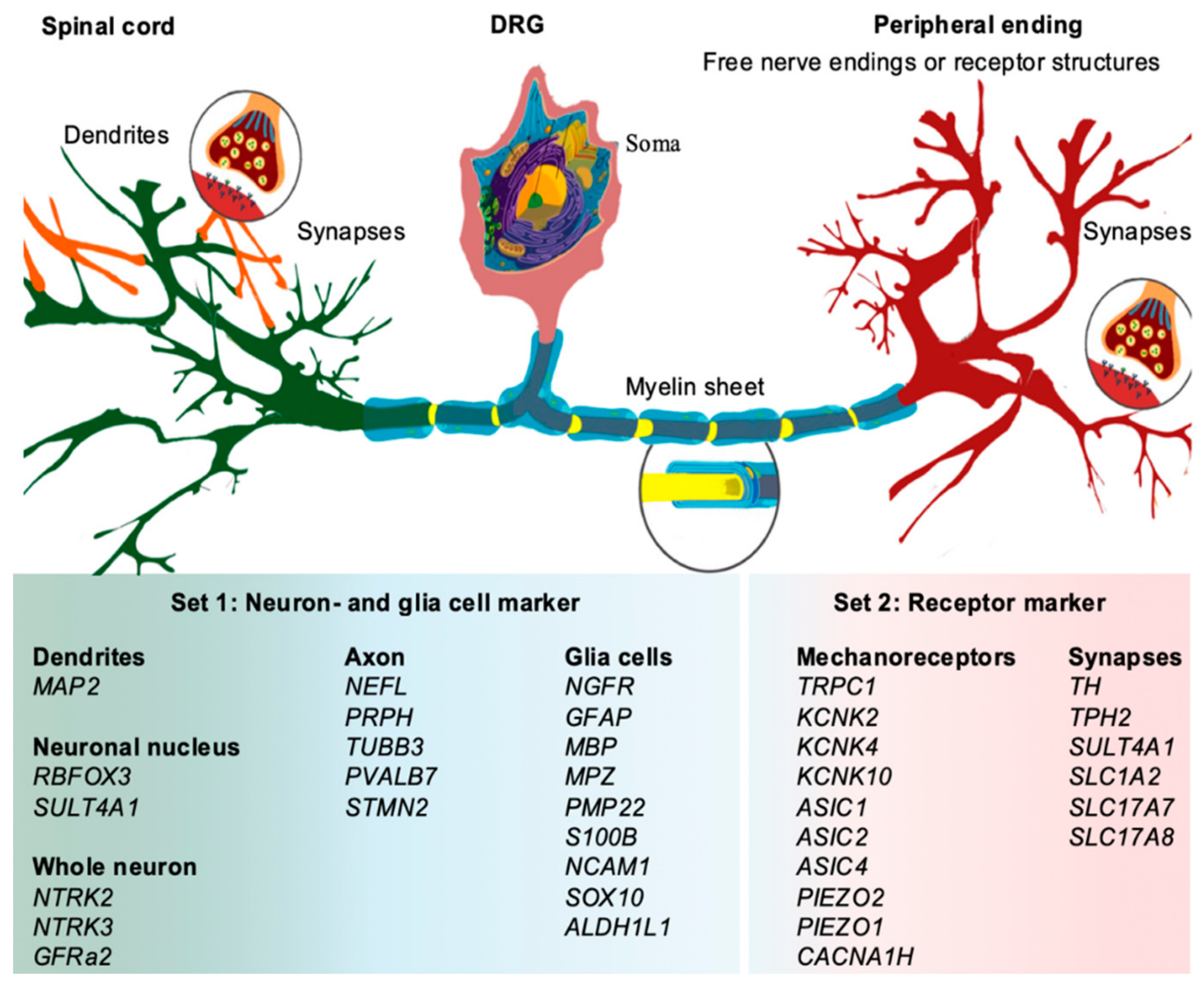
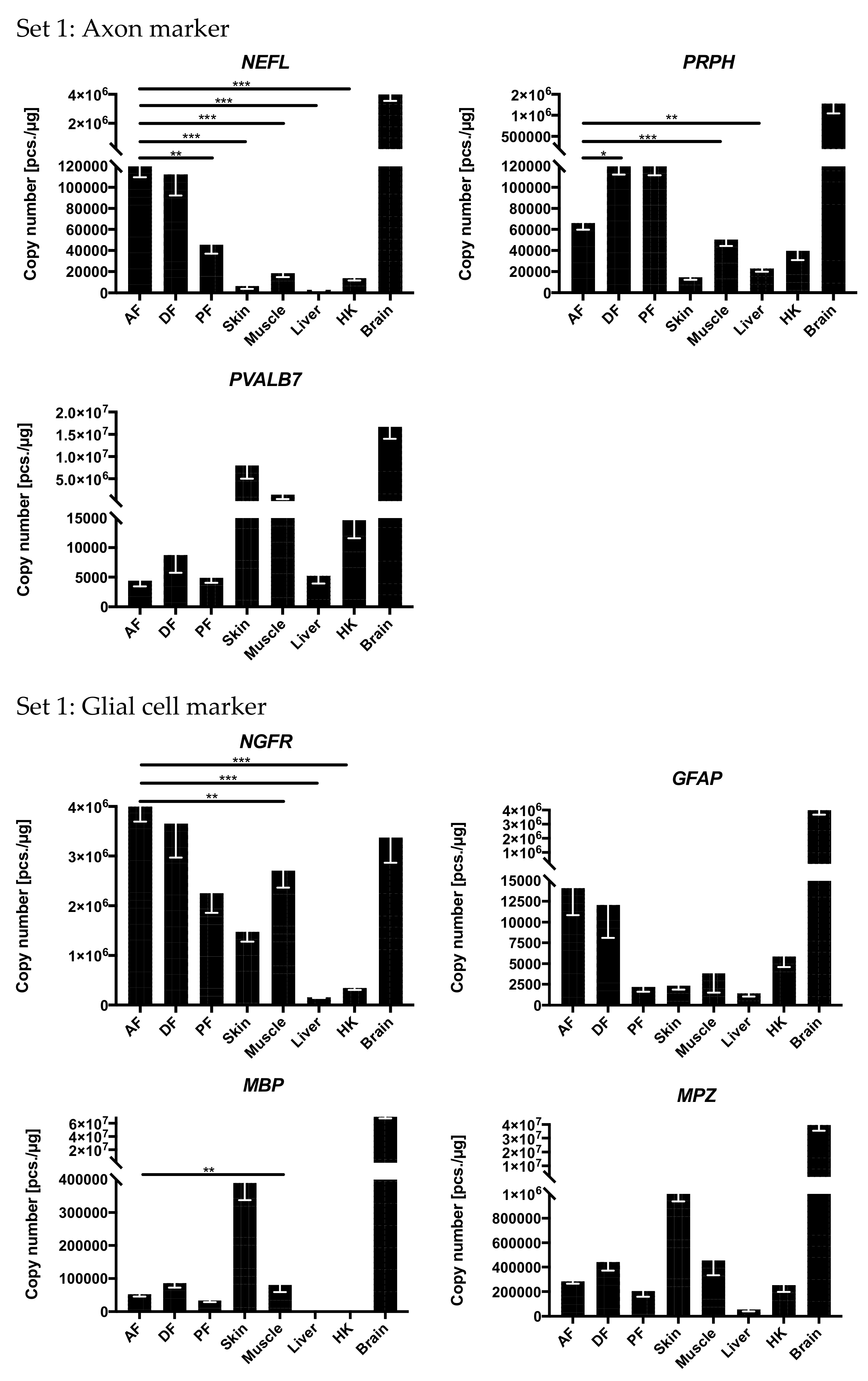


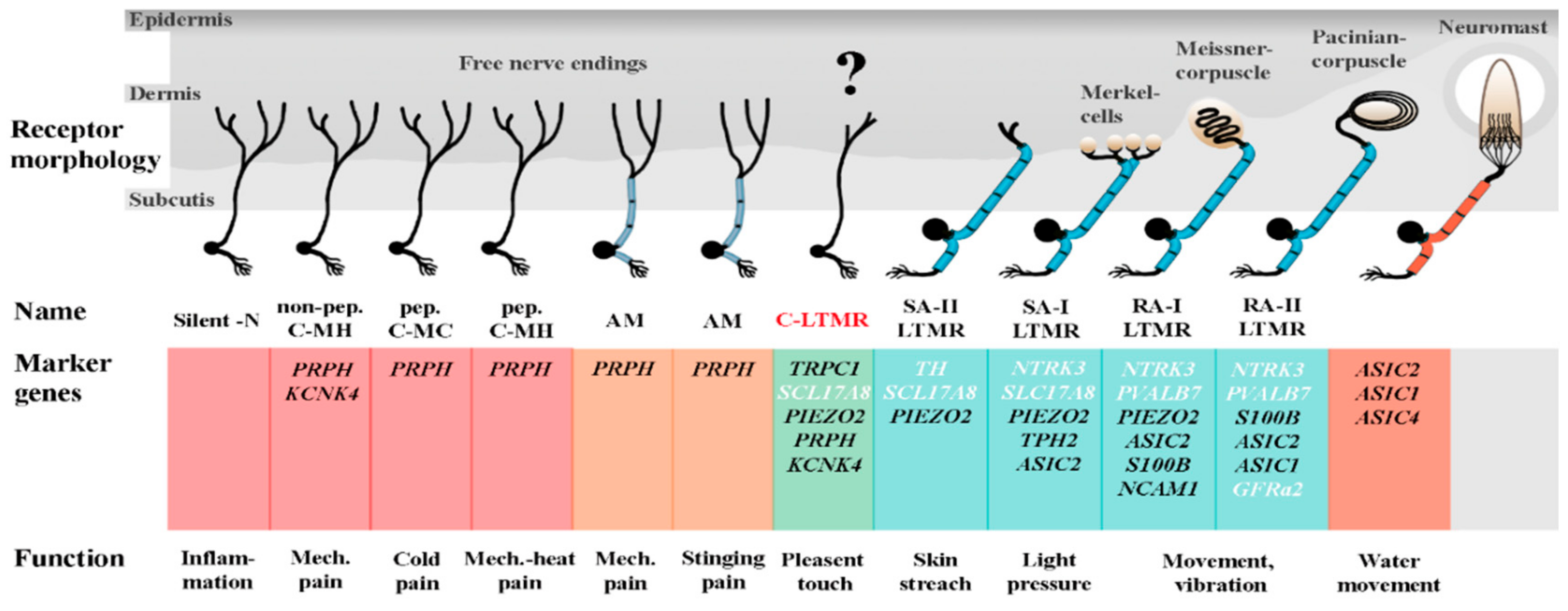
© 2019 by the authors. Licensee MDPI, Basel, Switzerland. This article is an open access article distributed under the terms and conditions of the Creative Commons Attribution (CC BY) license (http://creativecommons.org/licenses/by/4.0/).
Share and Cite
Koll, R.; Martorell Ribera, J.; Brunner, R.M.; Rebl, A.; Goldammer, T. Gene Profiling in the Adipose Fin of Salmonid Fishes Supports Its Function as a Flow Sensor. Genes 2020, 11, 21. https://doi.org/10.3390/genes11010021
Koll R, Martorell Ribera J, Brunner RM, Rebl A, Goldammer T. Gene Profiling in the Adipose Fin of Salmonid Fishes Supports Its Function as a Flow Sensor. Genes. 2020; 11(1):21. https://doi.org/10.3390/genes11010021
Chicago/Turabian StyleKoll, Raphael, Joan Martorell Ribera, Ronald M. Brunner, Alexander Rebl, and Tom Goldammer. 2020. "Gene Profiling in the Adipose Fin of Salmonid Fishes Supports Its Function as a Flow Sensor" Genes 11, no. 1: 21. https://doi.org/10.3390/genes11010021
APA StyleKoll, R., Martorell Ribera, J., Brunner, R. M., Rebl, A., & Goldammer, T. (2020). Gene Profiling in the Adipose Fin of Salmonid Fishes Supports Its Function as a Flow Sensor. Genes, 11(1), 21. https://doi.org/10.3390/genes11010021








